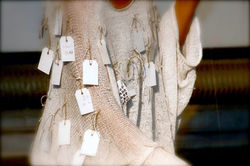 |  |  |
|---|---|---|
 |  |  |
 |
One Earth's Dreaming
Participative performance and installation of varying duration.
798 Art District, Beijing, ROC. On the occasion of 10th OPEN International Performance Art Festival, October 2009. Curated by Chen Jing/Martin Renteria
Grace Exhibition Space, New York, US. March 2010. Curated by Jill McDermid
Sarai Centre for the Studies of Developing Societies, New Delhi, IN. On the occasion of Open Minds, April 2011
One Earth's Dreaming is a communion of two persons, the individual and the collective, land and body, thought and matter. The body acts because the spirit talks: what appears divided unveils its insoluble relationship with another. Nothing stands for its own: the person's breath under the earth lets flowers grow. Stitching those flowers to another person's body uncovers the buried body. The viewer's thoughts and feelings are written on paper and buried under the earth. These thoughts give breath to the buried man, which lets us grow flowers stitched to the body, uncover the body, motion the spectators, and so forth. The meditative repetition of a limited action series creates a time bubble to rest and reflect. The levels of existence are not fixed. Each component can transform into something else during mutual exertion of influence. Everyone is invited to join this circle. Everyone is already part of it. It re-activates lost or buried genetic memories of natural coherence and positive, fertile dependencies. This entire construction chain is pure fragility and beauty.
+ Read the essay by Dana Altman, "The Reinvention of Time" in The Fall of Faust
Photographs by Yoko Toda
Once again, there is definitely the question of the communication process going on between the two performers, and between them and the audience, a flow of energy and signs that is being transmitted between all participants, and who become a whole during the event itself. Language is materialized by the actual writing, it becomes a sign, and the flowers given to everyone are another level of materialization, like a sign of absolution from the alienation, (...) like it was relinquished by means of the ritual to an instance that can further it and help clarification. One cannot be passive; one cannot just sit and wait for everyone else to exorcise their fear of communication and hold back in the process of recreating unity. The need to let go and do it is too strong, and the atmosphere is too encouraging. There is no judgment, and there is, in fact, no direct request. There is just an opportunity to do it, which is being provided in a conducive environment. And once again, each one of us is handed a loose script and allowed, or more likely, encouraged and supported to improvise according to our personal horizon of expectations. Once again, two issues on which Pagnes and Stenke have focused in the past are intimately entwined in the fabric of their performance: the importance of communication and the ritualistic aspects involved in facilitating it, as well as a personal version of bypassing alienation, the fundamental and rarely acknowledged problem of contemporary society. Once again, a person has to go over the fear of allowing him/herself to bring to the fore an intimate wish, verbalize it, and also objectify it and in the process of objectification, relinquish control and hope for the best.
Dana Altman in “The Reinvention of Time,” originally published in The Fall of Faust - Considerations on Contemporary Art and Art Action by Andrea Pagnes, Florence: VestAndPage press, 2010.
